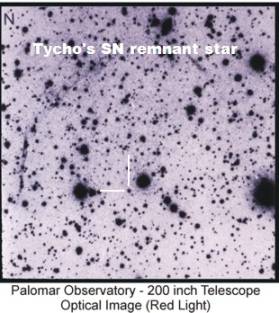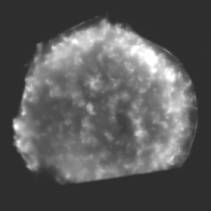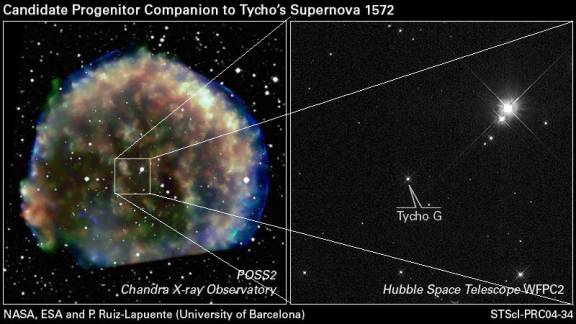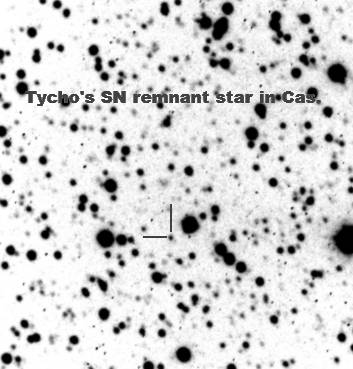



Supernova Sleuthing
Singles Out Tycho's Star
Star mystery solved after 400 years
By Tom McMahon
starmaven@starstream.net
Ever since astronomers classified Tycho Brahe’s supernova (SN) as Type I-a in the late 1960s, they have searched for the Danish royal astronomer progenitor star. Why? Such a star would have unique characteristics. Since only a few of this type of SN have been identified in our Milky Way Galaxy throughout recorded history, Tycho’s star is truly special. Although today we discover supernovae on a weekly basis, in distant galaxies, they are so far away that stars there cannot be readily studied.
Type I-a SN occur when a dense white dwarf accretes so much matter from its larger companion star, that it reaches a critical mass of 1.4 times that of our Sun. Once this point is reached the heat becomes so vast that it triggers a colossal thermonuclear blast incinerating the white dwarf. Nearly all of this matter, more than the mass of our Sun, is converted into high energy radiation that blasts outward into the universe at the speed of light.
When Tycho witnessed this event one night in 1572, he painstakingly plotted the celestial position and labeled it, nova Stella. It took more than 400 years for a consortium of astronomers to identify this special star.
SN explosions provide astrophysicists and nuclear scientists with the raw data they need to delve deeper into high energy physics. These celestial explosions may even help to confirm and expand modern string/M theory.
Supernova star explosions short lived
Supernovae explode randomly in galaxies throughout the universe. By astronomical yardsticks, measured in millions of units, their life cycles are miniscule – normally less that a year. That’s one reason why amateur and professional supernova hunters have teamed up to monitor the heavens continuously. SN cannot be predicted. Observational time on large professional telescopes is too precious to be spent on iffy searches for exploding SN stars. Therefore amateurs and professionals have teamed up to use smaller less costly equipment to systematically scan the night sky to discover SN blasts. (A follow-up article on this effort will appear next year.)
Historical records report only seven or eight supernovae events in our home Milky Way Galaxy. Most were observed before the discovery of telescope. Now we know that each of these titanic explosions left remnants in the form of expanding clouds of hot gasses. In 1758, in his new catalog, Charles Messier labeled the remnant of the SN observed on July 4, 1054 A.D., by Chinese astronomers as M1. (Crab Nebula) When SN 1054 appeared in the heavens during the Middle Ages it gleamed four times brighter than Venus, at magnitude -6.
After more than 400 years it took the power of the 200-inch telescope at the Mt. Palomar Observatory to identify some faint wisps of nebulosity at the position Tycho recorded for the 1572 SN remnant. (See: Fig. 1) Radio telescopes confirmed this discover soon after.

Fig. 1 – Note the faint wisps of the SN remnant at the left edge of the discovery plate image.
The orbiting Chandra X-Ray Telescope sent back detailed images. Tycho’s SN remnant emits more radiation at x-rays wavelengths than at visual frequencies. (See: Fig 2)

Fig. 2 - Tycho’s SN remnant X-ray image by Chandra X-ray Telescope.
Curiously, the larger star of the original orbiting pair survives. But is has been forever changed. And is grossly distorted, and accelerated in space by the force of the blast. Astrophysicists and astronomers have great interest in studying this mechanism. That is why astronomers, turned astro-detectives, launched a major effort to identify Tycho's star from among a number of candidates residing in the vicinity of Tycho’s SN remnant.
Clues for identifying Tycho’s star
Astronomers deduced that this star would exhibit identifiable characteristics:
First, the star’s radial velocity would have been boosted beyond that of its neighbors. In other words, like a powerful racing car with its accelerator pressed to the floor, it would move past nearby stars at a pace faster than any.
Second, the star’s outer layers would exhibit bloated characteristics caused by the blast.
Third, the star would lie near the center ofthe expanding SN remnant.
After hundreds of observations with world-class telescopes including: detailed images from the Chandra X-ray telescope Tycho’s star was identified. (Fig. 1) It alone among many met all the criteria. Corroborative evidence from spectroscopy by a many of the most powerful telescopes included: Keck I and Keck II, Hubble Space Telescope (HST), William Herschel Telescope (WHT) and Nordic Optical Telescope (NOT) confirmed that this dim star, shining at approximately magnitude 17 was Tycho’s star. The search was successful.
Finally after intense study these SN sleuths reported in the November, 2004, issue of the British journal Nature, that they had definitively identified Tycho star.
Upon seeing this discovery announced on the internet, I contacted Alex Filippenko at U C Berkeley, a copy of the report. He responded with an email copy of the 40-page research paper. This was a challenge I could not resist.
The challenge of imaging a unique star
The weather during last two weeks of October had been cloudy. Perhaps November would be better. On the morning of November 1, I queried the Blue Canyon Clear Sky Clock. The forecast predicted excellent skies that night. When I reached snow covered Blue Canyon late in the afternoon an hour before sunset the snow had melted on the tarmac.
I rolled the observatory roof back and flicked on the power. So far so good! My first action was to zero in on Navi * in Cassiopeia to tweak polar alignment. The CCD chip had stabilized -17 degrees F. so I focused the ST7XME CCD camera. I slewed the mount to 15-Kappa Cas., located near the star field containing Tycho’s star for final adjustment.
Then I punched in the coordinates of Tycho’s star and clicked the slew button. Without a hitch, the AP 600 mount whirred momentarily. I snapped a 10-second test image to check whether I was pointing at the proper star field. There it was on my laptop screen. But Tycho’s star did not appear in this 10-second integration. I increased exposure to 60 seconds. And when I adjusted the screen image brightness there it was just where it appeared on the 200-inch Palomar photographic plate.
Preparation had paid off. By printing images of the star field from the Palomar Schmidt Camera Sky Survey (Fig. 1) and identifying Tycho’s star on them from the Filippenko report images (See Fig. 3) assured me which star was Tycho’s.

Fig. 3 - From “The binary progenitor of Tycho Brahe’s 1572 supernova” (my enhancement)
But I needed to integrate an image that would go deeper - one with better signal to noise ratio. That would require longer exposure.
The sky had reached astronomical darkness with a bright Milky Way above. But the winter winds were beginning to blow. To avoid bloated and distorted stars I had to use shorter exposures than planned and then combine them in Maxim DL/CCD. There was another reason to work fast. A near full moon was about to rise at 8:30pm. This could wash out the dark sky background so important for faint star imaging. (The next day I measured Tycho’s star with software and it came in at about magnitude 17.)
I gambled! Perhaps a few short exposures of 180 seconds each could be taken between wind gusts. I could eliminate the bad images and combine the rest. Nothing ventured, nothing gained!
The next 45 minutes went according to plan. Wind gusts, degraded a number of exposures, but a enough seemed OK. By 9PM the moon was visible above the tree line so I shut down the equipment, rolled the roof on and drove home down the mountain.
The next morning, I found four of the 12, 3-minute exposures were acceptable. I combined them and subtracted a master dark frame. Then I carefully cropped my processed image to match the Palomar plate. I reversed it to black stars on a white background and labeled Tycho’s star. (Fig. 4)

Fig. 4 - Tycho’s star [4x180 sec guided, C8 @ f/6.3, ST-7XME, no filter] by Tom McMahon Nightwatch/Cielo Claro Observatory 11-01-04
Amateur technology has advanced so far that my CCD image taken with a standard C8 telescope compares favorably with the photographic plate taken with the 200-inch Palomar telescope forty years ago. The difference is that my image does not show the faint wisps of Tycho’s SN remnant because the discovery plate was taken with a red filter.
The next time I have a calm clear night at Blue Canyon I will retake Tycho’s star; this time with a red filter. Perhaps it too will show the gossamer filaments of Tycho’s SN remnant. I might even attempt an LRGB full color image. The challenges are endless.
# # #
Tom McMahon
*As a foot note to this excellent article by Tom: Navi (Gamma Cassiopeia) (Tshi), the whip star, was nick-named by astronaut Virgin Ivan "gus" Grisson. The star was used as a navigation reference point during space missions. Navi is Grisson's middle name spelled backwards.